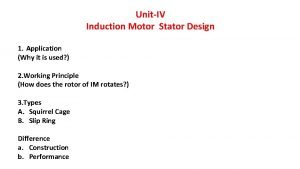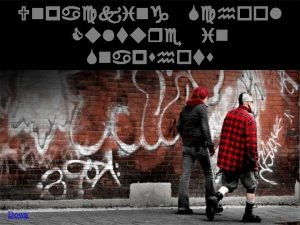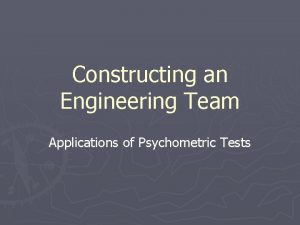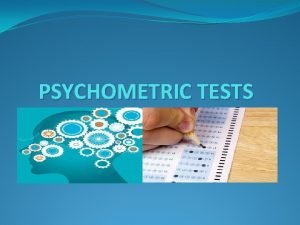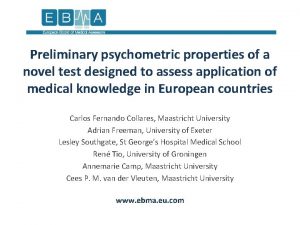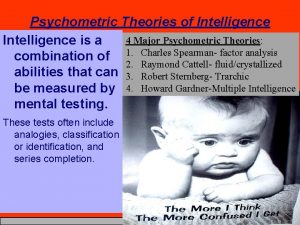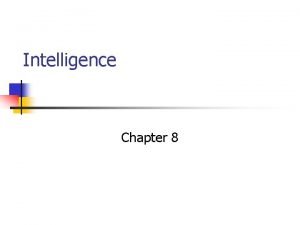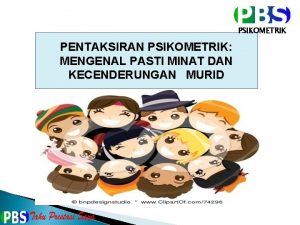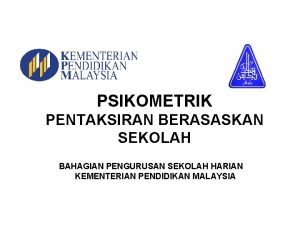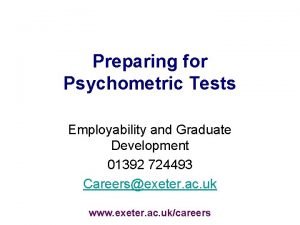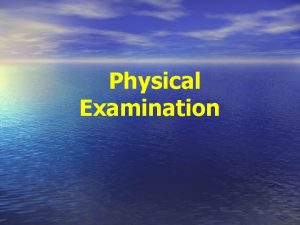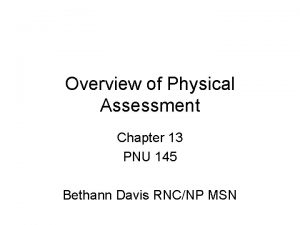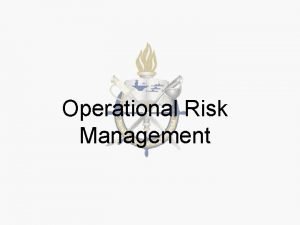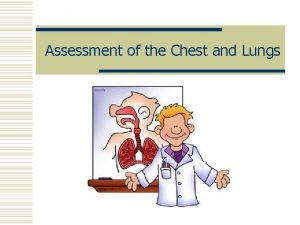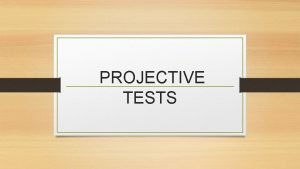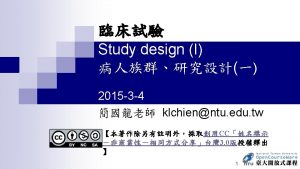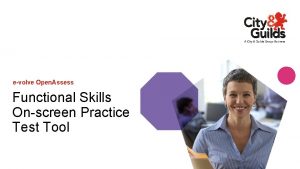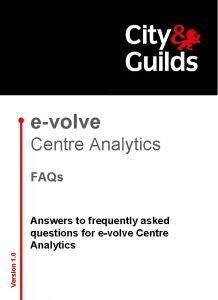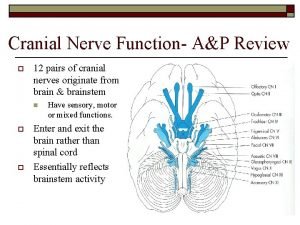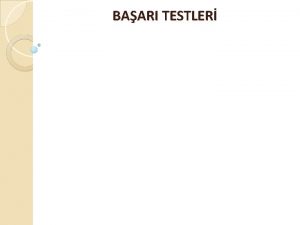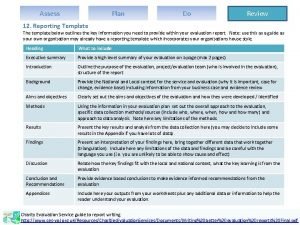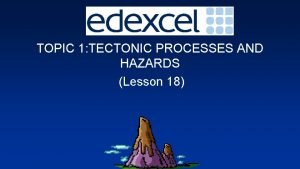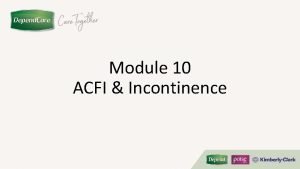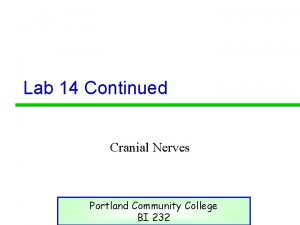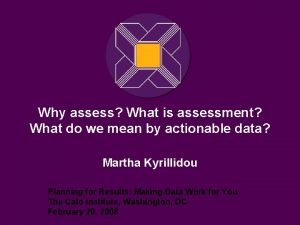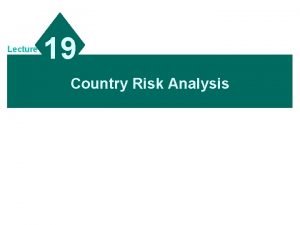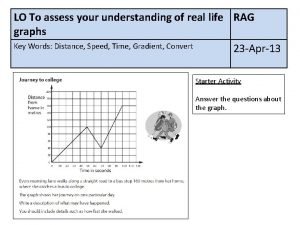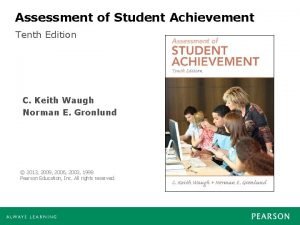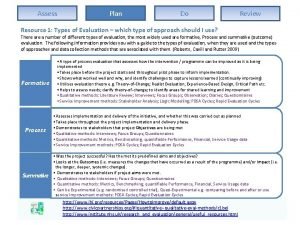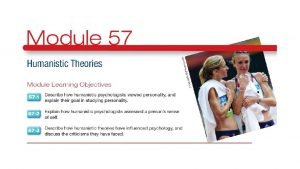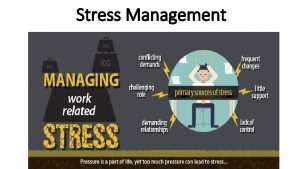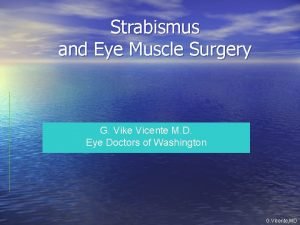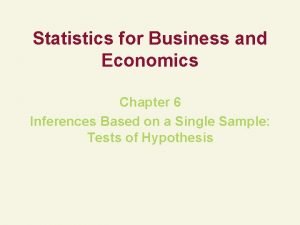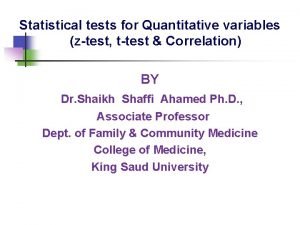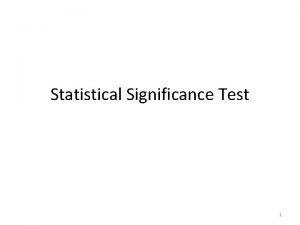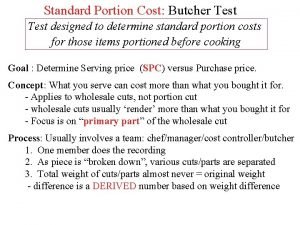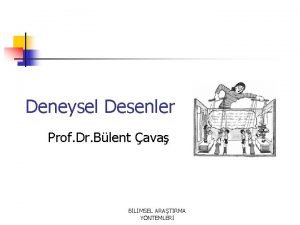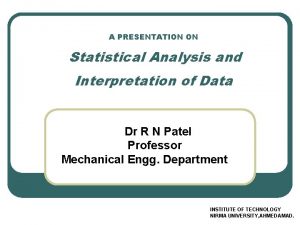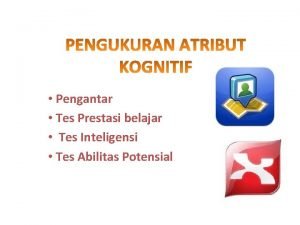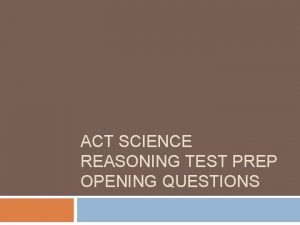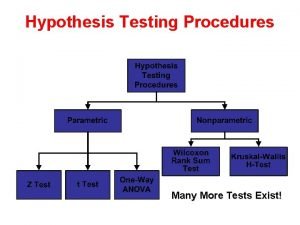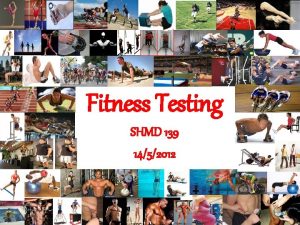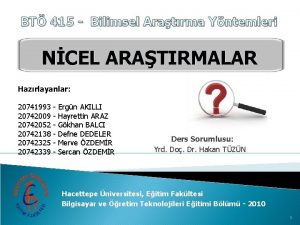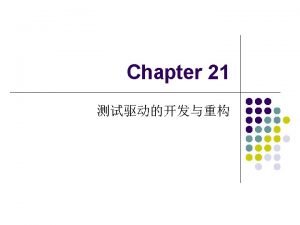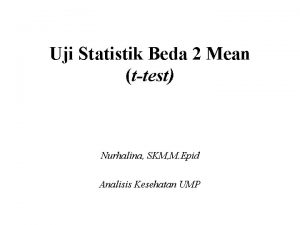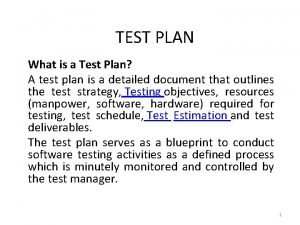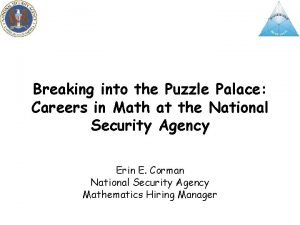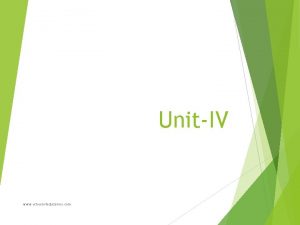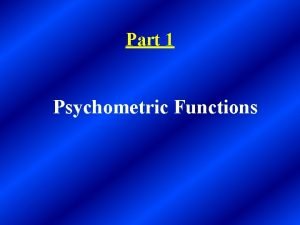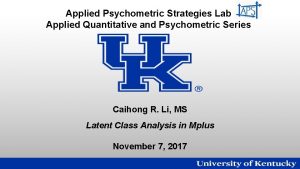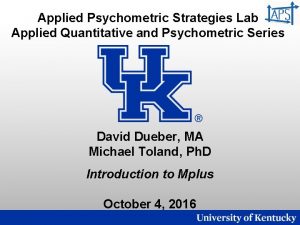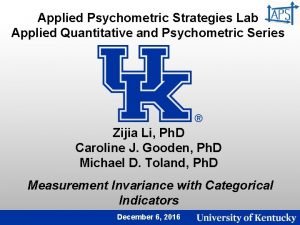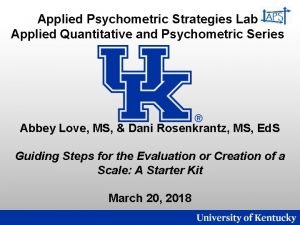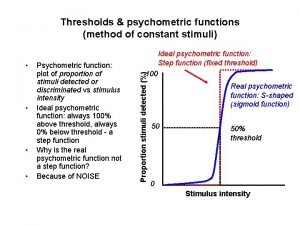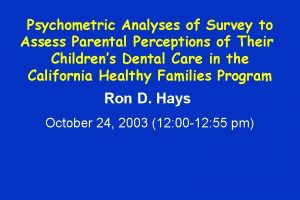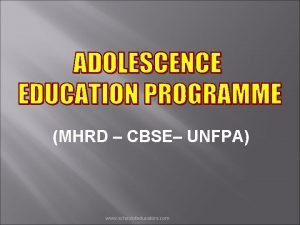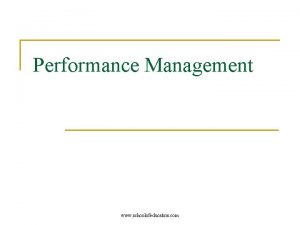UnitIV www schoolofeducators com PSYCHOMETRIC TEST to assess











































































- Slides: 75

Unit-IV www. schoolofeducators. com

PSYCHOMETRIC TEST to assess ability, personality and behavior used in the process of selection for job interviews, for assessment of school children and to diagnose people with mental health problems or psychopathological tendencies www. schoolofeducators. com

Psychological tests are effective tools to measure traits, feelings, beliefs and abilities that influence people’s behavior both normal and deviant www. schoolofeducators. com

Psychological tests are written, visual, or verbal evaluations administered to assess the cognitive and emotional functioning of children and adults. Psychological tests are used to assess a variety of mental abilities and attributes, including achievement and ability, personality and neurological functioning. www. schoolofeducators. com

Psychological tests are formalized measures of mental functioning. Most are objective and quantifiable. However, certain projective tests may involve some level of subjective interpretation. Psychological tests are available in various forms like inventories, questionnaires and rating scales. www. schoolofeducators. com

There are two types of psychological tests. 1. Tests to assess measures of maximum performance like ability, aptitude or attainment. 2. Tests to assess measures of typical performance like personality traits, beliefs, social competence, values, developmental milestones and interests, motivation or drive. www. schoolofeducators. com


Intelligence is a general capacity or potential for learning. According to Cleary, Humphrey’s Kendrick and Wesman (1975) ‘intelligence is the entire repertoire of acquired skills, knowledge, learning sets and generalization tendencies considered intellectual in nature that are available at any one period in time’.

Intelligence includes problem – solving ability, verbal ability, and social competence. Jensen (1985) suggested that the standard tests of intelligence reflect individual differences in the speed and efficiency to basic cognitive processes more than they reflect differences in the information content to which test takers have been exposed. Eg. Cognitive ability test, differential aptitude test (DAT)

uses It helps teacher to decide on instructional material to be used in the class or for an individual. It can be used in forecasting of future area of study or career. It can be used in vocational, Educational and personal guidance. It can be also used for selecting an individual for a job.

Limitations: Intelligence measures are not very stable in childhood. Specialized training required for administering the test. www. schoolofeducators. com

Aptitude Testing Aptitude is thought of as a natural tendency, special ability, or capacity or cluster of abilities. www. schoolofeducators. com

Aptitude may be defined as a trait that characterizes an individual’s ability to perform in a area or to acquire the learning necessary for performance in a given area. It presumes an inherent or native ability that can be developed to its maximum through learning or other experiences. www. schoolofeducators. com

Types of Aptitude Tests : There are different types of aptitude tests. Some of them are single aptitude tests like tests of mechanical aptitude, clerical aptitude, teaching aptitude, musical aptitude and so on. Such tests covering a group of related abilities are necessary for performing in an occupation like becoming a mechanic, clerk, teacher, musician etc. www. schoolofeducators. com

Another type of aptitude test is work sample aptitude test. It requires the individual to perform all or part of a given job under the conditions that exist on the job. An example of a work sample test for the job of automobile mechanic is to repair a faulty carburetor. www. schoolofeducators. com

The Differential Aptitude Tests (DATs) Developed in the US, but have been standardised for use in Irish schools. The DATs are designed for use in educational and vocational guidance and are used by school counsellors, personnel officers, psychologists and all persons concerned with assessing the intellectual characteristics and educational or vocational aptitudes of adolescents. www. schoolofeducators. com

They are group-administered tests of cognitive skills, Bennett, Seashore and Wesman (1984) battery consists of divided into eight subtests. The subtests are Verbal Reasoning, Numerical Ability, Clerical Speed and Accuracy, Abstract Reasoning, Mechanical Reasoning, Space Relations, Spelling, and Language Usage. The tests are typically administered to students in two sessions, each lasting under two hours.

The tests are performed under exam conditions and are strictly timed. All questions have a definite right or wrong answer. Very few candidates usually complete the entire test and the questions usually become progressively more difficult. The test is also age related. www. schoolofeducators. com

These tests can be used to help an individual 1. Chose among educational and career options based on strengths and weakness 2. Help an individual understand why they do well or poorly in certain subjects. 3. Can suggest new career options not previously considered. 4. Change or raise educational and career aspirations.

Verbal Reasoning This test measures the ability of a student to see relationships among words. The test consists of analogies. For example: ……. is to bark as cat is to ……. Select one of the following answers. A maiow ------- kitten B dog ----miaow C dog ------scratch D seal ---- kitten E tree ---- Scratch

This test assesses the ability to infer the relationship between the first pair of words and apply the relationship to the second pair of words. Verbal reasoning may be useful in helping to predict success in academic courses as well as in occupations where accurate communication is important.

A self-report inventory is a type of psychological test in which a person fills out a survey or questionnaire with or without the help of an investigator. Self-report inventories often ask direct questions about personal interests, values, symptoms, behaviors, and traits or personality types. www. schoolofeducators. com

Personality assesment Personality assessment tests that include questions dealing with situations, symptoms, and feelings. Test-takers-are asked to indicate how well each item describes themselves or how much they agree with each item. www. schoolofeducators. com

Background of personality assesment www. schoolofeducators. com

MMPI Minnesota Multiple Personality test. The Minnesota Multiphasic Personality Inventory (MMPI) is a standardized psychometric test of adult personality and psychopathology. [1] Psychologists and other mental health professionals use various versions of the MMPI to help develop treatment plans; assist with differential diagnosis; help answer legal questions (forensic psychology); www. schoolofeducators. com

screen job candidates during the personnel selection process; or as part of a therapeutic assessment procedure www. schoolofeducators. com

The Minnesota Multiphasic Personality Inventory, or MMPI, was created late in the 30’s by psychologist Starke R. Hathaway and psychiatrist J. C. Mc. Kinley, both whilst working at the University of Minnesota. Today, the MMPI is one of the most widely used and reliable clinical intelligence tests. www. schoolofeducators. com

The current MMPI test is made up of 567 “test items”. On average, subjects require an hour to an hour and a half to complete it. Specific MMPIfocused training is required, as well as a certified psychiatrist or psychologist, in order for the MMPI test to be given and evaluated. www. schoolofeducators. com

10 Scales of the MMPI The MMPI has 10 clinical scales that are used to indicate different psychological conditions. Despite the names given to each scale, they are not a pure measure since many conditions have overlapping symptoms www. schoolofeducators. com

Scale 1 – Hypochondriasis: This scale was designed to asses a neurotic concern over bodily functioning. The 32 -items on this scale concern somatic symptoms and physical well being. The scale was originally developed to identify patients displaying the symptoms of hypochondria. Scale 2 – Depression: This scale was originally designed to identify depression, characterized by poor morale, lack of hope in the future, and a general dissatisfaction with one's own life www. schoolofeducators. com

Scale 3 – Hysteria: The third scale was originally designed to identify those who display hysteria in stressful situations. Those who are well educated and of a high social class tend to score higher on this scale. Women also tend to score higher than men on this scale. Hysteria, identifies a person’s ability to cope with stressful situations. Surprisingly, people with more money and education display more hysteria, and women on average score higher than men. www. schoolofeducators. com

Scale 4 - Psychopathic Deviate: Originally developed to identify psychopathic patients, this scale measures social deviation, lack of acceptance of authority, and amorality. This scale can be thought of as a measure of disobedience. High scorers tend to be more rebellious, while low scorers are more accepting of authority. Despite the name of this scale, high scorers are usually diagnosed with a personality disorder rather than a psychotic disorder. www. schoolofeducators. com

Scale 5– Masculinity/Femininity: This scale was designed by the original author’s to identify homosexual tendencies, but was found to be largely ineffective. High scores on this scale are related to factors such as intelligence, socioeconomic status, and education. omen tend to score low on this scale. www. schoolofeducators. com

Scale 6 – Paranoia: This scale was originally developed to identify patients with paranoid symptoms such as suspiciousness, feelings of persecution, grandiose selfconcepts, excessive sensitivity, and rigid attitudes. Those who score high on this scale tend to have paranoid symptoms. www. schoolofeducators. com

Scale 7 – Psychasthenia: This diagnostic label is no longer used today and the symptoms described on this scale are more reflective of obsessivecompulsive disorder. This scale was originally used to measure excessive doubts, compulsions, obsessions, and unreasonable fears. www. schoolofeducators. com

Scale 8 – Schizophrenia: This scale was originally developed to identify schizophrenic patients and reflects a wide variety of areas including bizarre thought processes and peculiar perceptions, social alienation, poor familial relationships, difficulties in concentration and impulse control, lack of deep interests, disturbing questions of self-worth and selfidentity, and sexual difficulties. This scale is considered difficult to interpret. www. schoolofeducators. com

Scale 9 – Hypomania: This scale was developed to identify characteristics of hypomania such as elevated mood, accelerated speech and motor activity, irritability, flight of ideas, and brief periods of depression. www. schoolofeducators. com

Scale 10 – Social Introversion: This scale was developed later than the other nine scales as is designed to assess a person’s tendency to withdraw from social contacts and responsibilities. www. schoolofeducators. com

Abbreviation Description What is measured No. of items 1 Hs Hypochondria sis Concern with bodily symptoms 32 2 D Depression Depressive Symptoms 57 Hysteria Awareness of problems and 60 vulnerabilities Psychopathic Deviate Conflict, struggle, anger, respect 50 for society's rules Masculinity/F emininity Stereotypical masculine or feminine interests/beh aviors Number 3 4 5 Hy Pd MF www. schoolofeducators. com 56

6 7 Pa Pt Paranoia Level of trust, suspiciousness, 40 sensitivity Psychasthenia Worry, Anxiety, tension, doubts, obsessiveness 48 78 8 Sc Schizophrenia Odd thinking and social alienation 9 Ma Hypomania Level of excitability 46 0 Si Social Introversion People orientation 69 www. schoolofeducators. com

The 16 PF The Sixteen Personality Factor Questionnaire (16 PF), is a self-report personality test developed over several decades of empirical research by Raymond B. Cattell, Maurice Tatsuoka and Herbert Eber. www. schoolofeducators. com

The 16 PF provides a measure of normal personality and can also be used by psychologists, and other mental health professionals, as a clinical instrument to help diagnose psychiatric disorders, as well as help with prognosis and therapy planning. The 16 PF instrument provides clinicians with a normal-range measurement of anxiety, adjustment, emotional stability and behavioral problems. [1 n also be used within other areas of psychology, such as career and occupational selection. [3] www. schoolofeducators. com

www. schoolofeducators. com

Myers–Briggs Type Indicator (MBTI) The Myers–Briggs Type Indicator (MBTI) is an introspective self-report questionnaire designed to indicate psychological preferences in how people perceive the world and make decisions www. schoolofeducators. com

The MBTI was constructed by Katharine Cook Briggs and her daughter Isabel Briggs Myers. It is based on the typological theory proposed by Carl Jung[4] who had speculated that there are four principal psychological functions by which humans experience the world – sensation, intuition, feeling, and thinking – and that one of these four functions is dominant for a person most of the time. [ www. schoolofeducators. com

"The underlying assumption of the MBTI is that we all have specific preferences in the way we construe our experiences, and these preferences underlie our interests, needs, values, and motivation. "[7] www. schoolofeducators. com

The Briggs Myers Type Indicator Handbook was published in 1944. The indicator changed its name to "Myers–Briggs Type Indicator" in 1956. [14] Myers' work attracted the attention of Henry Chauncey, head of the Educational Testing Service. Under these auspices the first MBTI Manual was published in 1962. www. schoolofeducators. com

The MBTI looks at four aspects of your personality: Favorite world: Information: Decisions: Structure: www. schoolofeducators. com

Favorite world: What is the orientation of your focus and how are you energized? Do you prefer to focus on the outer world or on your own inner world? Extraverted Characteristics (E) – Outgoing, action oriented, seeks breadth of knowledge, frequent interaction and gets energy from spending time with people Introverted Characteristics (I) – Reflective, thought oriented, seeks depth of knowledge, substantial interaction and gets energy from spending time alone www. schoolofeducators. com

Information: Sensing Characteristics (S) – Lives in the present, uses the five senses for practical and real solutions, memory recall is rich in detail, improvises from past experiences, comfortable with clear and concrete information Intuition Characteristics (N) – Lives in the future, looks beyond the five senses for imagination and new solutions, memory recall emphasizes patterns and contexts, improvises from theoretical understanding, comfortable with ambiguous and fuzzy information www. schoolofeducators. com

Decisions: Thinking Characteristics (T) – Instinctively search for facts and logic, naturally drawn to accomplishing tasks, able to provide objective analysis, accepts conflict as natural Feeling Characteristics (F) – Instinctively look at personal feelings and empathy, naturally sensitive to people’s needs and reactions, able to seek consensus, unsettled by conflict www. schoolofeducators. com

Structure: Judging Characteristics (J) – Plan details in advance, focus on task-related action, keeps ahead of deadlines, naturally use standard procedures and organization to manage life Perceiving Characteristics (P) – Comfortable without details to act, likes to multi-task and have variety, tolerant to deadlines and time pressure, naturally avoid commitments which interfere with flexibility and freedom. www. schoolofeducators. com

The Thematic Apperception Test (TAT) In the Thematic Apperception Test, an individual is asked to look at a series of ambiguous scenes. www. schoolofeducators. com

Proponents of the technique assert that subjects' responses, in the narratives they make up about ambiguous pictures of people, reveal their underlying motives, concerns, and the way they see the social world. Historically, the test has been among the most widely researched, taught, and used of such techniques. www. schoolofeducators. com

The participant is then asked to tell a story describing the scene, including what is happening, how the characters are feeling and how the story will end. The examiner then scores the test based on the needs, motivations and anxieties of the main character as well as how the story eventually turns out. www. schoolofeducators. com

The TAT was developed during the 1930 s by the American psychologist Henry A. Murray and lay psychoanalyst Christiana D. Morgan at the Harvard Clinic at Harvard University www. schoolofeducators. com

Anecdotally, the idea for the TAT emerged from a question asked by one of Murray's undergraduate students, Cecilia Roberts. She reported that when her son was ill, he spent the day making up stories about images in magazines and she asked Murray if pictures could be employed in a clinical setting to explore the underlying dynamics of personality. www. schoolofeducators. com

After World War II, the TAT was adopted more broadly by psychoanalysts and clinicians to evaluate emotionally disturbed patients. Later, in the 1970 s, the Human Potential Movement encouraged psychologists to use the TAT to help their clients understand themselves better and stimulate personal growth www. schoolofeducators. com

The complete version of the test contains 32 picture cards. Some of the cards show male figures, some female, some both male and female figures, some of ambiguous gender, some adults, some children, and some show no human figures at all. One card is completely blank and is used to elicit both a scene and a story about the given scene from the storyteller. www. schoolofeducators. com

www. schoolofeducators. com

what has led up to the event shown what is happening at the moment what the characters are feeling and thinking what was the outcome of the story www. schoolofeducators. com

www. schoolofeducators. com

www. schoolofeducators. com

www. schoolofeducators. com

www. schoolofeducators. com

www. schoolofeducators. com

www. schoolofeducators. com

www. schoolofeducators. com

www. schoolofeducators. com

www. schoolofeducators. com

www. schoolofeducators. com

www. schoolofeducators. com

www. schoolofeducators. com

www. schoolofeducators. com

Thank You
 Unitiv
Unitiv Bài thơ mẹ đi làm từ sáng sớm
Bài thơ mẹ đi làm từ sáng sớm Cơm
Cơm Toxic school culture
Toxic school culture Schoolofeducators
Schoolofeducators Schoolofeducators
Schoolofeducators Engineering psychometric test
Engineering psychometric test Sales psychometric test
Sales psychometric test Psychometric test
Psychometric test Psychometric test
Psychometric test Charles spearman g factor
Charles spearman g factor Psychometric approach to intelligence
Psychometric approach to intelligence Psychometric tests
Psychometric tests Apa itu psikometrik
Apa itu psikometrik Apa maksud ppsi
Apa maksud ppsi Judgement questions examples
Judgement questions examples Why is tactile fremitus increased in pneumonia
Why is tactile fremitus increased in pneumonia Hr planning process
Hr planning process Tacticle fremitus
Tacticle fremitus How to assess alert and oriented
How to assess alert and oriented 5 steps of orm
5 steps of orm Nutrition assessment
Nutrition assessment How to assess alert and oriented
How to assess alert and oriented Retail organization
Retail organization Decreased tactile fremitus
Decreased tactile fremitus Aatsecureassess
Aatsecureassess Sqa solar open access
Sqa solar open access Projective techniques are used to assess personality by:
Projective techniques are used to assess personality by: Blocked random assignment
Blocked random assignment City and guilds open assess
City and guilds open assess City and guilds evolve secure access login
City and guilds evolve secure access login Vestibulocochlear nerve examination
Vestibulocochlear nerve examination Standart başarı testleri
Standart başarı testleri Assess plan do review template
Assess plan do review template Assess plan act
Assess plan act Tectonic hazard profile
Tectonic hazard profile Acfi behaviour charts
Acfi behaviour charts Oculomotor nerve function test
Oculomotor nerve function test Why assess
Why assess Fedcb
Fedcb Techniques to assess country risk
Techniques to assess country risk Ask assess advise
Ask assess advise Assess your understanding
Assess your understanding To assess achievement at the end of instruction is
To assess achievement at the end of instruction is Assess plan do review model
Assess plan do review model Humanistic psychologists may assess personality by
Humanistic psychologists may assess personality by Disadvantages of criterion referenced assessment
Disadvantages of criterion referenced assessment Www.123 test.com/disc-personality-test/
Www.123 test.com/disc-personality-test/ Manifest squint meaning
Manifest squint meaning Cover uncover test vs alternating cover test
Cover uncover test vs alternating cover test Statistics for business and economics chapter 6 solutions
Statistics for business and economics chapter 6 solutions Z test table
Z test table Univariate analysis tests
Univariate analysis tests Unpaired t test vs paired
Unpaired t test vs paired What is butcher test
What is butcher test When do we use z test or t test
When do we use z test or t test Nonparametric test
Nonparametric test Lancaster red-green test
Lancaster red-green test Deneysel desen örnekleri
Deneysel desen örnekleri 123 test.com/career-test
123 test.com/career-test When to use z test and t test
When to use z test and t test Www.123 test.com/disc-personality-test/
Www.123 test.com/disc-personality-test/ Contoh tes prestasi dalam psikologi
Contoh tes prestasi dalam psikologi Science reasoning test
Science reasoning test Unit test algebra 2
Unit test algebra 2 123 test.com/career-test
123 test.com/career-test Nonparametric test
Nonparametric test Sit and reach measurement
Sit and reach measurement Compairson test
Compairson test Tekrarlı ölçümler deseni
Tekrarlı ölçümler deseni Extends testcase
Extends testcase 123 test.com/career-test
123 test.com/career-test Perbedaan z test dan t test
Perbedaan z test dan t test Test strategy includes
Test strategy includes Dolaxin
Dolaxin Nsa math proficiency test
Nsa math proficiency test
